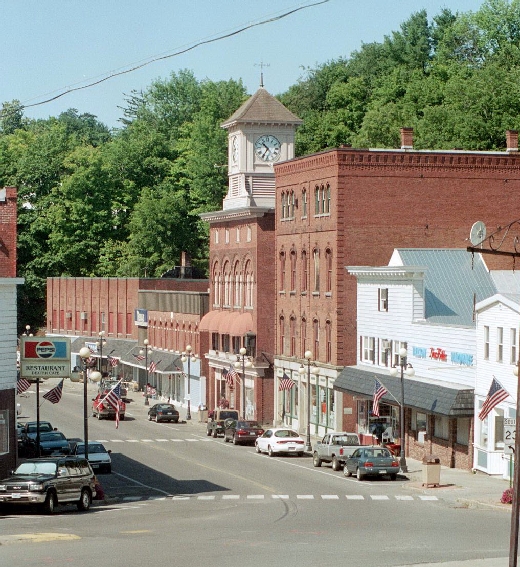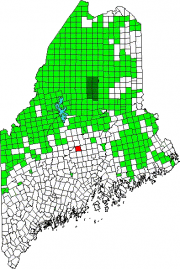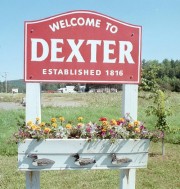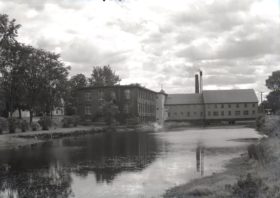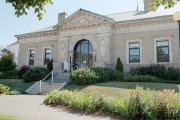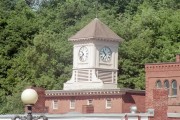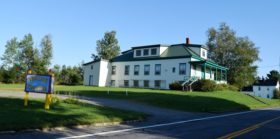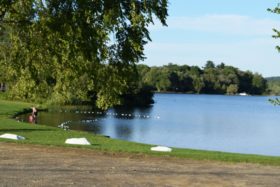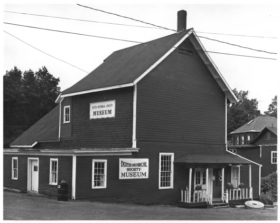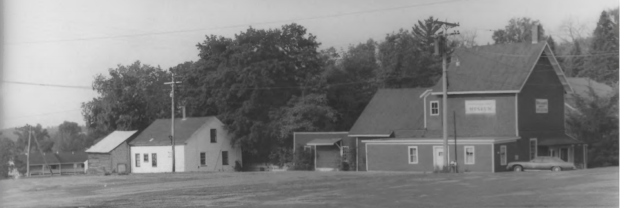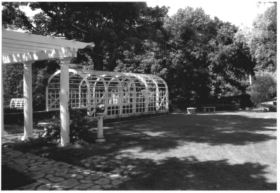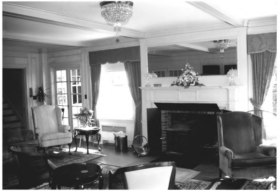| Year | Population |
|---|---|
| 1970 | 2,567 |
| 1980 | 4,286 |
| 1990 | 4,419 |
| 2000 | 3,890 |
| 2010 | 3,895 |
| Geographic Data | |
|---|---|
| N. Latitude | 45:02:23 |
| W. Latitude | 69:16:47 |
| Maine House | District 104 |
| Maine Senate | District 4 |
| Congress | District 2 |
| Area sq. mi. | (total) 37.2 |
| Area sq. mi. | (land) 35.2 |
| Population/sq.mi. | (land) 110.7 |
County: Penobscot
Total=land+water; Land=land only |
|
Congressional
Medal
of Honor
Winner
Indian Wars
JAMES E. BAILEY
[DEX-ter] Town in Penobscot County, incorporated on June 17, 1816 from township T4 R5 NWP. Surveyed in 1772, the township remained unsettled until 1800 the hardy pioneer Ebeneezer Small arrived, planted a crop, cobbled together a shelter, and brought his wife the following year.
Samuel Dexter, for whom the town was named, never saw it. He had served as Secretary of War, Treasury and State in various U.S. cabinets.
The Abbott woolen mill was erected in 1835, starting an industry that lasted for over 150 years. Recent closings of manufacturing firms have contributed to the decline in population in the 1990-2000 decade.
In the late 19 century, Dexter’s economic environment, according to George Varney, was characterized by water power and mills:
The streams that furnish power are the outlet of Dexter and Spooner’s ponds, Kenduskeag River, in the south-eastern part of the town, and Sebasticook Main Stream, which winds along westward through the entire northern border of the town. At the north-west corner, upon Main Stream, are lumber and shingle mills, a brick yard, etc; and on the outlet of Spooner’s Pond in the southern part of the town, are one or more mills. In all, Dexter has 26 powers, 26 of which have an aggregate fall of 331 feet. . . .
The principal manufactures are boots and shoes, long lumber, boxes, doors, sashes and blinds,churns, carriages, woolen cloths, mens clothing, cooper’s ware, flour, meal and feed, iron castings, stoves, plows, soap, leather, marble-work, tinware, etc.
The latter list is virtually unmatched in the history of what are now small towns in Maine. At the time, Dexter appears to have been a manufacturing giant in the area. Note the title of George H. Haynes’ 1899 book below.
The town is the birthplace in 1888 of legislator, congressman, governor, and U.S. Senator Ralph Owen Brewster.
Lake Wassookeag covers 1,062 acres near the main village. With a boat launching facility and a nearby recreational space, the lake attracts families, swimmers and people hoping to land a fish or two.
A few miles away on the North Dexter Road is the Wayside Theater and Grange. The Grange dates from around 1916. Noting difficulty in meeting attendance and costs, a group of Dexter residents bought the building. The Wayside Theater occupies the building and hosts community musical and theatrical entertainment. The members of the Theater are also members of the Grange.
Government: Council-Manager
Additional resources
**Call, Bert. Abbott Mill Image courtesy of Special Collections, Raymond H. Fogler Library. DigitalCommons@UMainephoto https://digitalcommons.library.umaine.edu/bert_call/3106/
Chase, Halcyon. The Early History of the Town of Dexter. Dexter, Me. Eastern Gazette. 1904.
Dexter (Me.). High school. Class of 1916. Brief History of Dexter, Prepared by Members of the Class of 1916, Dexter High School, as a part of their graduation exercises on the hundredth anniversary of the incorporation of the town. 1816-1916. Dexter, Me. Press of Eastern Gazette. 1916. [University of Maine, Raymond H. Fogler Library, Special Collections; Maine State Library; Bangor Public Library]
Dexter Spirit of an Age: defining Dexter’s Character. Dover, N.H. Arcadia Publ. c1995.
Dexter, Spirit of an Age. Vol. II: our neighborly neighbors: 200 years of life in rural Dexter, Maine 1800-2000. Publications Committee, Dexter Historical Society. c1999.
Dover, Foxcroft, Guilford, Sangerville, Dexter, Newport, Corinna Souvenir 1908. 1908? [University of Maine, Raymond H. Fogler Library, Special Collections]
The Eastern Gazette: Centennial Issue. Dexter, Me. The Eastern Gazette. 1953.
Haynes, George H. The Scenic Beauties, Industries and Resources of Dexter, Maine. Dexter, Me. Press of W.S. Ladd. 1899?
Jacobs, Isabel A. Bubbles in the Sun. Dexter, Me. Dexter Historical Society. 2000.
*Maine. Historic Preservation Commission. Augusta, Me. Additional text and photos at National Register of Historic Places.
Wayside Grange and Theater. https://www.facebook.com/WAYSIDSTAGE (accessed October 5, 2019)
Plummer, Stanley. A History of the Town of Dexter, 1801-1901. Dexter, Me. The Dexter Historical Society. 1976.
Plummer, Stanley. A History of the Town of Dexter Down to 1915. Dexter, Me. Eastern Gazette. 1942-1943.
Richards, Lawrence A. The Effects of the Depression Years, 1930-1938, on Dexter, Maine. 1970. (Thesis (Honors)–University of Maine, 1970) [University of Maine, Raymond H. Fogler Library, Special Collections]
Varney, George J. A Gazetteer of the State of Maine. 1886. p. 199-200.
Whitney, Richard. Dexter in 1878. 1988. [University of Maine, Raymond H. Fogler Library, Special Collections]
Wintle, Fred L. When Weavers Wove: Short Stories of a Small New England Mill Town. New York. iUniverse. c2007. [University of Maine, Raymond H. Fogler Library, Special Collections; Maine State Library]
National Register of Historic Places – Listings
Abbott Memorial Library
[Maine Route 7] The 1894 Abbott Memorial Library, designed by J. William Beal of Boston, is a well-executed example of the Renaissance Revival style. It is a one-story, brick building with a hipped roof covered with slates, two internal brick chimneys and a granite foundation. This remarkable structure is notable for a small rather remote industrial town.
Funding for the land and building was provided by George Amos Abbott, a leading figure in Dexter and owner of Amos Abbott and Company, a woolen mill founded by his father. The mill apparently was the first of its kind in Maine. The other building in Maine with a similar Renaissance open loggia (a roofed open gallery) is the Walker Art Gallery at Bowdoin College designed two years earlier by Standford White. It is tempting to think that J. William Beal may have been influenced by White.* [See photo above.]
Bank Block
[15 Main Street] The 1876 Bank Block is a four-story, five-bay brick building that exhibits the Italianate style in its lower three levels and the Romanesque Revival style in its top floor resulting from reconstruction by architect/builder Henry P. Dexter. In contrast to the red brick upper stories, the building’s first floor storefront is of granite and cast iron. It stands in the middle of Dexter’s historic commercial district. Built to house the Dexter Savings Bank, the First National Bank and the Masonic Hall, the Block appears to have been the first brick commercial building in downtown. It was designed by Bangor architect George W. Orff.
Founded in 1867, the Dexter Savings Bank was the first bank in Dexter. Eight years later the Dexter First National Bank was chartered. The following year, the two institutions combined efforts to erect a substantial brick block to house their respective offices. The H.C. Parsons insurance agency was on the second floor. The third floor housed the Masonic Hall and the first floor contained two retail businesses.The Bank Block is believed to occupy the original site of the Dexter House, an early nineteenth hostelry that was a prominent landmark on Main Street. It was moved to an adjoining lot, then was relocated about 1906 to make way for a new municipal office. An 1878 robbery of the Dexter Savings Bank resulted in the murder of the bank’s treasurer, John Wilson Barren. Although several people were charged, no convictions were made. The Bank Block continued to serve as a banking institution until the mid 1990s.*
Dexter Grist Mill
[Maine Route 7] During the 18th and 19th centuries, the grist mill was a feature of most rural Maine communities. By the last quarter of the 20th century the state had only about a half dozen surviving examples. The Dexter Grist Mill is one of the most well preserved. Its simple frame construction with its series of irregular additions exemplifies the direct, “make-do” quality of rural basic industrial architecture.
In 1801, the first year of settlement, Samuel Elkins came from Cornville to begin a saw and grist mill. The following year the mill was established at the outlet of Lake Wassookeag. Its ownership changed hands several times before it was purchased by Jonathan Farrar in 1817.
Farrar was a successful Skowhegan merchant and lumberman who invested in Dexter’s industrial future. He realized the town merited a separate saw mill and grist mill. So he expanded the saw mill at the large outlet and moved the grist mill to the site of the present mill in the center of town.
To provide power, he dug a mill pond and a canal, which runs under Dexter’s Main Street, bringing water from the Sebasticook River. In 1818 he built a small building to serve as the grist mill. He owned the mill until 1830 when he sold it. In 1854 it was purchased by the firm of Farrar and Cutler, which replaced the old mill that year, building the present one on the same location.
The Grist Mill was operated by one family for most of its history. In 1854 Farrar and Cutler hired James Quimby Maxfield as their miller. He was followed by two of his sons. His daughter’s husband, Samuel L. Small, a mill employee, bought the mill in 1882, passing it to his son Harold in 1912. Harold Small ran the business until 1960 when it was leased to his daughter and son-in-law Mr. and Mrs. Clair Wilkins. In 1966 the Beacon Feed Company bought the mill’s grain business. After about a year, Beacon closed the mill. The Town of Dexter purchased it and granted the it to the Dexter Historical Society.
The Miller’s House, just south of the mill, was built in 1838 by Seba F. Weatherbee. The Cape Cod form has Greek Revival style details. The central entrance consists of a single door with sidelights, framed by modified Doric pilasters. A 1 ½ story addition is attached to the south end.*
[This description is condensed from the 1975 nomination to the National Register of Historic Places. Earle G. Shettleworth, Jr. photos]
Dexter Universalist Church
[Church Street] Among the best work of the prolific Thomas W. Silloway of Boston, a noted architect and a Universalist minister, this is really a building of 1867-70 although the frame of the original 1829 church remains intact. The architect and church elders concluded that the basic structure the old church could be reused. The ceiling and all walls (except the front) of the sanctuary are completely covered by pressed metal. [See photo above.]
Silloway designed a great many churches throughout New England and the Vermont Statehouse. He also wrote several books on architecture and theology. Other work in Maine includes the Universalist Church in Lewiston (destroyed), the Trinitarian Church in Castine, the Unitarian-Universalist Church in Calais (destroyed), the Universalist Church in Augusta (remodeled for shops), the Baptist Church in Springvale, and the Second Congregational Church in Biddeford (altered).*
Zions Hill
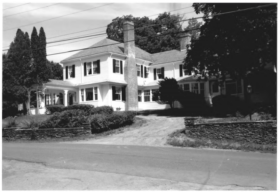 [37 Zions Hill] Zions Hill, home of Owen and Dorothy Brewster, is the largest and most architecturally significant early 20th century house in Dexter. Designed in the Colonial Revival style by the firm of John Calvin Stevens and John Howard Stevens, it was built at the peak of Senator Brewster’s career as one of Maine’s leading politicians. As a major reconstruction of an older building, the Stevens firm developed an imaginative floor plan which departed from the symmetry of traditional Colonial Revival. With its landscaped grounds and prominent siting, Zions Hill was for many years one of the major architectural showplaces of northern Maine.
[37 Zions Hill] Zions Hill, home of Owen and Dorothy Brewster, is the largest and most architecturally significant early 20th century house in Dexter. Designed in the Colonial Revival style by the firm of John Calvin Stevens and John Howard Stevens, it was built at the peak of Senator Brewster’s career as one of Maine’s leading politicians. As a major reconstruction of an older building, the Stevens firm developed an imaginative floor plan which departed from the symmetry of traditional Colonial Revival. With its landscaped grounds and prominent siting, Zions Hill was for many years one of the major architectural showplaces of northern Maine.
The framing for the main section dates from the 1870s when a house was built on this site by William E. Brewster, father of Ralph Owen Brewster. Owen Brewster, who grew up in the original house, attended Bowdoin College, Harvard University and the University of Maine before practicing law in Portland. He served in the Maine State Legislature and was elected Governor for two terms, 1924-1929.
In 1929 Brewster and his wife, the former Dorothy Foss, returned to Dexter where he practiced law and acquired his father’s house on Zions Hill. In 1934 he hired the Portland firm of Stevens and Stevens to build a new house using the frame of the old building. Brewster’s wife Dorothy played an important role in working with the architects, especially regarding the landscaping. A consummate hostess and prominent “club-woman”, she was by all accounts highly effective as a politician’s wife.* [Roger G. Reed photos]


